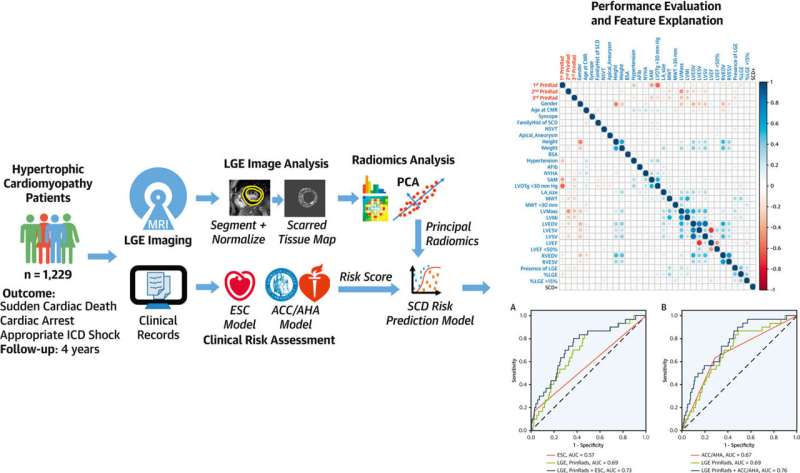This article has been reviewed according to Science X's editorial process and policies. Editors have highlighted the following attributes while ensuring the content's credibility:
fact-checked
trusted source
proofread
AI can improve predictions of sudden cardiac death in patients with common heart condition

Medical images contain a wealth of information beyond what is visible to the human eye. Now, scientists are using radiomics, a relatively new form of AI that uses a quantitative approach to medical imaging, to extract much more of the data captured in medical images, which can then be used to better understand disease and to predict patient outcomes.
In a new study, physician-researchers at Beth Israel Deaconess Medical Center (BIDMC) and Lahey Hospital & Medical Center (LHMC) investigated whether radiomic data extracted from magnetic resonance imaging of people with a common heart condition may help predict arrhythmic events and potentially sudden death in these patients.
In a study of more than 1,200 patients at three international medical centers, the scientists determined that including radiomic features in risk models improved predictions and identified a previously unknown feature as a significant marker of sudden cardiac death. The team's findings were published in the JACC: Cardiovascular Imaging.
About one in 500 people, or 1.5 million people in the United States, have hypertrophic cardiomyopathy (HCM), a genetic heart condition in which the heart muscle becomes abnormally thick, making it harder for the heart to pump oxygenated blood to the body effectively. While sometimes symptomless, HCM can cause shortness of breath, arrhythmia and sudden cardiac death. Patients diagnosed with the condition are typically monitored for the presence of cardiac scar tissue—a major risk factor for sudden cardiac death—with magnetic resonance imaging (MRI).
"Sudden cardiac death is a devastating complication in hypertrophic cardiomyopathy, and we need better algorithms to identify those at high risk of developing lethal arrhythmia," said corresponding author Reza Nezafat, Ph.D., director of the Cardiac MR Center at BIDMC and professor of medicine at Harvard Medical School. "Effective prevention of sudden cardiac death can be achieved, but the low discrimination power of established clinical risk factors limits these efforts. We investigated the prognostic value of integrating radiomic features of scar into existing risk stratification models."
The team, including lead author Ahmed S. Fahmy, Ph.D., of BIDMC, analyzed cardiac imaging data from 1,229 patients with HCM treated at academic medical centers in Boston, Toronto and Florence between 2003 and 2018. Each patient's risk of experiencing sudden cardiac death within a five-year period was calculated using two established risk score models that depend on clinical and imaging variables, including age and family history of sudden cardiac death, as well as thickness of the heart wall and scar tissue burden.
Next, the researchers used the patients' MRIs to create scarred tissue maps, extracting a comprehensive set of radiomic features including 14 shape parameters and 930 texture features, leading to 1,888 radiomic features representing the shape and texture of each patient's scar tissue map. From these data, the team developed new mathematical models for predicting the probability of sudden cardiac death.
When the scientists looked at the patients' outcomes, they saw that 30 patients (or 2.4%) experienced a sudden cardiac death event within a follow-up period of up to 6.5 years. Integrating radiomic features with the clinical risk assessment scores significantly improved risk prediction, with one model accurately flagging 19 of the patients who experienced a sudden cardiac death event as high-risk.
Moreover, the analysis revealed one radiomic feature with significant prognostic value for predicting sudden cardiac death risk—a texture feature of the scar tissue map. While further investigation is needed, the finding demonstrates how radiomics may help reveal new biomarkers that may be useful for monitoring patients with HCM and other conditions with few clinical signs and symptoms.
"Advances in imaging technologies and image analysis tools have allowed the investigation of novel features to predict the risk of sudden cardiac death in patients with HCM," said Martin Maron, MD, Director of the Hypertrophic Cardiomyopathy Center at LHMC. "Our proof-of-concept study showed that radiomics analysis can add incremental prognostic value to current established risk prediction models, potentially saving lives."
More information: Ahmed S. Fahmy et al, Radiomics of Late Gadolinium Enhancement Reveals Prognostic Value of Myocardial Scar Heterogeneity in Hypertrophic Cardiomyopathy, JACC: Cardiovascular Imaging (2023). DOI: 10.1016/j.jcmg.2023.05.003




















